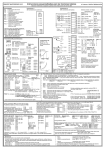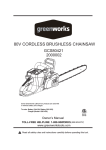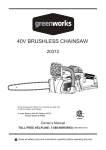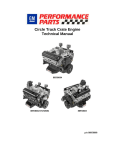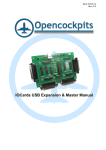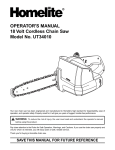Download Estate TAWS800JQ Top Load Washer - dekdrain_topside_cantilevered_instructions
Transcript
® ain dr Patent #6,385,931,B1 Patent #6,415,571,B2 Water Diversion System Topside Cantilevered Installation Instructions for New Construction I. Getting Started Before starting the installation, read these instructions completely and determine the placement of all the interrelated parts of the system. DEK Drain is installed after the posts, beams and joists are in place, but before the decking is installed. See Getting Started Photos. DEK Drain is designed to channel water into a collection gutter creating a complete water diversion system. Gutters are not provided by DEK Drain. Standard rain gutters are fine. You can match the color and style of the gutters on your home. The first step in planning your installation is to determine the placement of the collection gutter. The DEK Drain system will be designed to drain to this point. We recommend positioning the gutter along the inside face of the beam as illustrated in Figure 1 below. See Gutter Placement Photos. MAIN PANEL BEAM FIGURE 1 - OVERVIEW When ordering your system, select main panels which are long enough to extend from the ledger board to the mid-point of the collection gutter. Select reverse panels long enough to extend from the outside edge of the deck to overlap the main panels by at least 12”. When measuring a bay with an angle feature, be sure to measure the longest side of the angle cut. (A bay is the area between two joists.) 1 When ordering your DEK Drain system, be sure to alert us about the following conditions: • Any unusual framing including doubled, sistered, or spliced joists • Obstructions in the frame such as railing posts, gas lines, downspouts or blocking. (Blocking can be used with DEK Drain, but it must be installed low in the bay so that there is at least 1” of separation between the drain panel and the blocking.) • A “non-standard” bay which is wider that the other bays (the material can easily be cut for narrower bays). II. The Four Parts of the DEK Drain System All four parts of the DEK Drain system are made of the same flexible and durable rubber membrane. 1. Flashing Strip is 12” wide. The Flashing Strip is installed along the wall of the building directing water into the panels. The Flashing Strip is wrapped with yellow tape and can easily be cut to size. 2. Panels are self-forming and prefabricated for 12”, 16”, or 24” on-center framing. A pitch of ¼” per foot of run is built into the drain panels. The Drain Panels install over the joists and form a trough between the joists to drain the water to a collection point. The panels overlap on the top edge of the joists. There will be one panel for each bay. • The Main Panels drain water from the portion of the deck extending from the edge of the building to the collection gutter. • The Reverse Panels drain water from the portion of the deck beyond the supporting beam, back across the beam and into the main panels for collection in the gutter. 3. Cap Strips are 4” wide and run the length of the joists. After the panels are installed, the Cap Strips are centered on top of the joists to prevent seepage into the joint on the top of the joists. Cap Strip is wrapped with orange tape. 4. Bibs are sized for 12”, 16”, or 24” framing schedules. The Bibs are installed vertically at the end of the drain panels to prevent the water discharge from overshooting the collection gutter. The Bibs are labeled with pink stickers. 2 III. Tools and Fastening The only tools needed are: • Stapler-- a hammer-tacker (also known as a slap stapler), a pneumatic stapler or electric tool. • Sharp scissors • Razor knife A 1/2” T-50 type staple is recommended. Staples should be at least half an inch long and half an inch wide. You don’t need to use galvanized or stainless steel staples. The staples are only used to hold the system in place until the decking boards are installed. The decking boards will permanently hold the system in place. All four parts of the DEK Drain system are installed with staples. Spacing of staples must be adequate to hold the product in place. The DEK Drain membrane is self sealing and using a substantial number of staples will not cause leakage. IV. The Installation Process The DEK Drain system is installed in eight steps: Step 1--Installing the Flashing Strip along the ledger board The Flashing Strip must be installed along the entire length of the ledger board (the board attached to the house). The Flashing Strip channels water runoff from the sidewall of the house into the panels. Proper installation of this Flashing Strip is critical. The following describes the process for attaching the Flashing to the wall of the house depending on the type of building materials. 3 Wood Framing with Siding The Flashing Strip should be inserted under the siding and turned up the wall 3” - 5”. The Flashing will extend down across the top edge of the ledger board and extend out over the Panels and Caps about 6”. Caution: If building paper, felt paper, house wrap or other sheathing protective material is present, it MUST be sliced and the flashing strip inserted UNDER the building paper. When in place, the flashing strip should be stapled or taped to the sidewall of the house. BUILDING PAPER (TYVEK, etc.) SIDING FLASHING CAP STRIP PANEL 2 PANEL1 JOIST LEDGER BOARD BUILDING SIDE WALL FIGURE 2 - FLASHING WOOD FRAMING WITH SIDING Brick, Block, Stone and Stucco Walls There are two options. The first option is for the Flashing to be installed directly to the face of the masonry wall. We recommend the use of good quality adhesive sealant such as M-1, manufactured by Chem Link (800-826-1681), as it adheres well to the rubber membrane and most other common building materials. The installation is the same as with other siding material, except in this instance the Flashing is attached directly to the face of the masonry wall. The second option is to cut a horizontal cavity (a “reglet”) into the face of the wall into which the leading edge of the Flashing is attached. The attachment of the Flashing material can be accomplished with either adhesive or special glues. A metal starter flashing such as copper, galvanized steel, lead or aluminum is recommended for inserting into the reglet. The DEK Drain Flashing Strip is inserted under the downward protruding edge of the metal flashing. An application of adhesive caulk or glue is recommended to hold the top edge of the Flashing in place. 4 Before the decking is installed, be certain the Flashing overlaps the Panels and Caps. There may be a slight buildup of material at the joint where the deck joins the building structure. To achieve a clean, tight joint between the decking board and the house, it may be desirable to “backcut” the decking board to allow for the buildup of material. MASONARY WALL ADHESIVE/CAULK x x x x x x DECK BOARD NOTE BACK CUT DEK Drain® FLASHING JOIST FIGURE 3 - FLASHING MASONRY WALLS After the Flashing Strip is installed, it is helpful to fasten it up out of the way until the Panels and Caps are installed. See additional Flashing Photos. Step 2--Installing the Bibs The Bibs are installed vertically at the Discharge end of each Panel. The Bibs direct the discharge from the drain panels into the gutter. The Bibs may be stapled to the inside face of the beam. The two edges of the Bib wrap around and attach to the inside face of the two joists that form the bay. The Bib is designed to extend down into the gutter, but should not lay on the bottom of the gutter. A simple trim with a sharp scissors may be necessary. Any water that would overshoot the gutter will hit the Bib and drain into the gutter. See additional Bib Photos. 5 Step 3—Installing the Panels Positioning and Alignment The panels are shaped like a trapezoid with one end wider than the other. There is one pre-fabricated panel for each bay. The narrow or “Head” end (marked with a red label) is positioned at the ledger board and the wider or “Discharge” end (marked with a green label) away from the house. When the Panel is stapled to the joists, the additional width automatically creates a descending trough providing the required pitch to drain the water away from the house. Below are photos of the panels from above and underneath the deck. Start by laying a panel over the joists of any bay aligning it so that the panel covers the top of the joists. The outside edges of the panel should be flush with the outside edges of the joists for each bay. Hint: Before laying out the panel, place a few short pieces of wood across the bay to support the panel while you work. Pull them out as you move down the panel. Position the panel so that the Head end will extend over the top edge of the ledger board and turn up the wall approximately one inch. Don’t be concerned if the leading edge of the Head end of the panel isn’t square. 6 USE ONLY THE SIDE EDGES OF THE PANEL FOR ALIGNMENT, KEEPING THEM FLUSH WITH THE OUTSIDE EDGES OF THE JOISTS. Stapling the Panels Once the panel is in proper alignment with the joists, tack a few staples to hold the head end in place. Move down the length of the panel to approximately the mid point. Pull the discharge end of the panel toward the collection gutter, but do not stretch the material. Align the Panel with the outside edges of the joists and tack both sides of the panel into place. Move to the Discharge end of the Panel and repeat this operation. Smooth an even belly in the trough of the Panel as you run down the joist. Avoid creases or “gather” in the panel material. If wrinkles or “gathers” occur, remove staples from one side of the panel and gently move the panel edge toward or away from the building until the wrinkle is relieved. When the Panel is properly oriented, go back and staple the rest of the Panel edges. You can’t use too many staples to secure the DEK Drain Panels. • After the first Panel is complete, the next Panel will overlap the first Panel on the top of the same joist. It is important to line up the edge of the next Panel with the outside edge of the joist. You will not be able to see the outside edge of the common joist, as it is covered by the first Panel. However, the outline of the outside edge of the joist should be visible through the membrane of the Panel and it can also be felt by touch. Use the same process to install the remaining Panels. CAP STRIP PANEL BAY JOIST NOTE ALIGNMENT OF PANEL EDGES WITH OUTSIDE EDGE OF JOISTS FIGURE 4 - POSITIONING THE PANELS Non-Standard Bays Often there will be one bay which is a different width from the standard framing schedule. If the opening is narrower than the others, a standard Panel may be used. It will belly down further in the bay, but generally is not noticeable. The Panel for this bay may be carefully trimmed back equally on both sides to better fit the opening. 7 If the opening is wider than the other bays, a larger size Panel must be used or a custom Panel fabricated. NEVER STRETCH A PANEL WIDER THAN THE SPECIFID WIDTH (12”, 16”, 24” framing schedules). Alternatively, an additional joist may be added, forming two smaller bays. See additional Panel Photos. Step 4--Installing the Reverse Panels Cantilevered systems use Reverse Panels to drain water from the portion of the deck beyond the supporting beam, back across the beam and into the main panels for collection in the gutter. When ordering your DEK Drain system, select reverse panels long enough to extend from the outside edge of the deck to overlap the main panels by at least 12”. Follow the same steps used for installation of the Main Panels. The photo below shows the reverse panels following installation. Step 5--Installing the Cap Strips After the Panels are stapled into place, the 4“ Cap strips are centered and stapled on top of all the joists, covering the overlapping edges of the Drain Panels. The Cap Strips divert water away from the overlapped joint and into the Panels. For doubled joists, or joists wider than 1 ½”, wider Cap Strip must be used. The Cap Strips covering the joists should be centered on the joist so that they “dog ear” down on each side. There will now be three layers of rubber membrane on top of the joists—the two overlapping Panels and the Cap Strips. See additional Cap Strip Photos. 8 Step 6--Trimming the Discharge End of the Panel The discharge end of the Panel should be aligned over the mouth of the gutter and trimmed straight across so that the discharge will empty into the collection gutter. The Panel should be separated from the Bib by at least 1”. Sometimes the discharging water wants to “curl” or wrap around the bottom edge of the panel. A thin bead of caulk across the underside of the panel will break the surface tension and prevent “curling”. A “tongue” may also be fashioned to the discharge edge of the drain panel by placing two slices in the trough of the drain panel approximately 2” wide and 2” back into the panel from the discharge edge. Allow the tongue to dangle down toward the center of the collection gutter. Step 7—Testing and Access for Maintenance Test the system before putting the deck boards down. Spray water down on the panels to be sure water is draining away from the house and into the collection gutter with no leaking. It is recommended that several decking boards near the house be secured with screws so that the boards may be taken up from time to time. This will provide access to the Drain Panels for flushing of debris which may have fallen through the deck boards. A standard garden hose is usually all that is needed. It is also a good idea to allow access to the high end of the gutter so it can be flushed out from time to time. Thank you for choosing the DEK Drain® water diversion system. If you have questions regarding installation, please contact us. Our staff is available Monday through Friday 9:00 AM to 4:30 PM Eastern Time to answer your questions. Or you can email us at [email protected]. 1-866-DEK-Drain (866-335-3724) [email protected] 9









